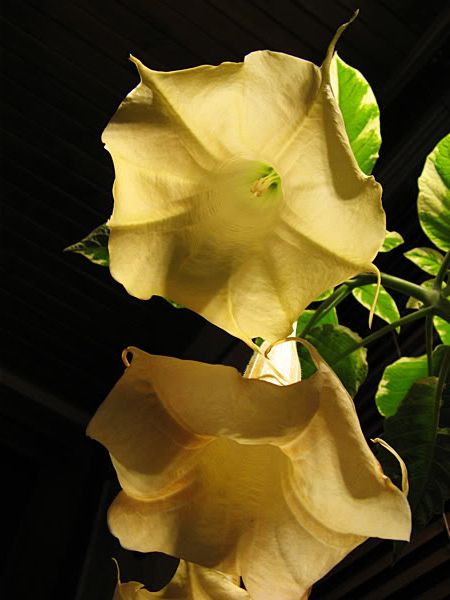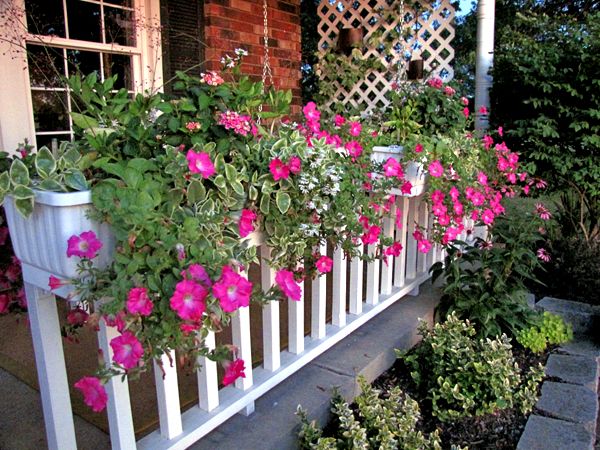 The first time I noticed that some plants are more fragrant at night than during the day was when I first had to bring the Brugmansias inside for the winter. Being in a small enclosed space, you just couldn't miss the fresh exuberant scent reminiscent of lemon soap. A single plant with just two blooms can scent the entire main floor of our two-story house. Sometimes you can even catch a whiff of it at the top of the stairs.
The first time I noticed that some plants are more fragrant at night than during the day was when I first had to bring the Brugmansias inside for the winter. Being in a small enclosed space, you just couldn't miss the fresh exuberant scent reminiscent of lemon soap. A single plant with just two blooms can scent the entire main floor of our two-story house. Sometimes you can even catch a whiff of it at the top of the stairs.
There are other plants that have some scent during the day, but become noticeably more fragrant at night:
- Flowering Tobacco (Nicotiana sp.)
- Hosta
- Dianthus
- Climbing Hydrangea (Hydrangea anomala petiolaris)
- Honeysuckle (Lonicera japonica)
- Night-blooming Jasmine (Cestrum nocturnum)
- Evening Stock (Matthiola incana)
- Dame's Rocket (Hesperis matronalis)
- Moonflower (Ipomoea alba)
- Sweet Autumn Clematis (Clematis terniflora)
- Evening Primrose (Oenothera)
- Night Phlox
- Petunia
- Four O'clocks (Mirabilis jalapa)
- Gardenia
- Tuberose (Polianthes tuberosa)
This list is by no means exhaustive, but contains some of the more commonly grown night-fragrant blooms.

Flowers are fragrant in the first place because of scent glands in their blooms called osmophores. Not every flower smells good to humans, but the scent isn't really there for us. A flower's unique odor is meant to attract a particular group of pollinators. Some of those pollinators are most active at night, so the plant accommodates them. It's simply a matter of perpetuating the species.
We're attracted to some of these same scents, many of which are used in perfumes and colognes. If Brugmansia came bottled, I'd buy it.
















 "Bejeweled"
"Bejeweled"



9 comments:
Kylee- Your photos are just POPPING today. Thank you for inspiring.
What a fragnant post! And educative, too! I never smelled my hostas at night, but now I know! Thank you Kylee!
Great post Kylee, I can almost cyber-sense the fragrants.
I love your blog!
I founded it because I'm studyin English and I have to do a presentation about one of my interests. (So, sorry for my English)
I live in Uruguay, a little country of South America. Now we're in spring, but I enjoy your fall photos.I'm amazed of nature's cycles!
Thanks for share with us!
I don't think I've smelled Brugs before. I know I love the smell of petunias and nicotianas in the evenings.
Bren ~ Thank you! I wish you could SMELL them! :-)
Tatyana ~ I've never smelled them at night either, but when I did research as to which plants were night fragrant, hostas popped up on a couple of lists. I'll have to wait until next summer to sniff for myself. I know some of mine smell pretty good during the day, but I have a feeling not all hostas are night fragrant. We'll see!
Tyra ~ If only we had Smell-o-Vision, eh?
Rafaella ~ Gracias for visiting and commenting, all the way from Uruguay! Tyra, one commenter above you, is from Sweden! Isn't it great how the internet has brought the whole world closer?
I've actually been to South America twice, visiting our exchange student daughter, Karina, in Ecuador. BEAUTIFUL! And lucky you, to be experiencing spring (primavera?)now. I wish spring were closer for us, but we have to go through winter first. Good luck on your presentation! :-)
Delicious post, Kylee. The scent of dianthus always makes me sigh.
I love fragrant plants and really didn't know there were so many there were more fragrant at night. Very cool.
Catherine ~ Oh, you MUST find a brug to sniff! Yes, I was shocked when I first smelled a petunia and found that it smelled so good!
T Opdycke ~ I've never sniffed a dianthus. Next year! Although I do still have some red ones blooming...
Janet ~ I didn't know there were so many either, until I researched for this post!
Post a Comment